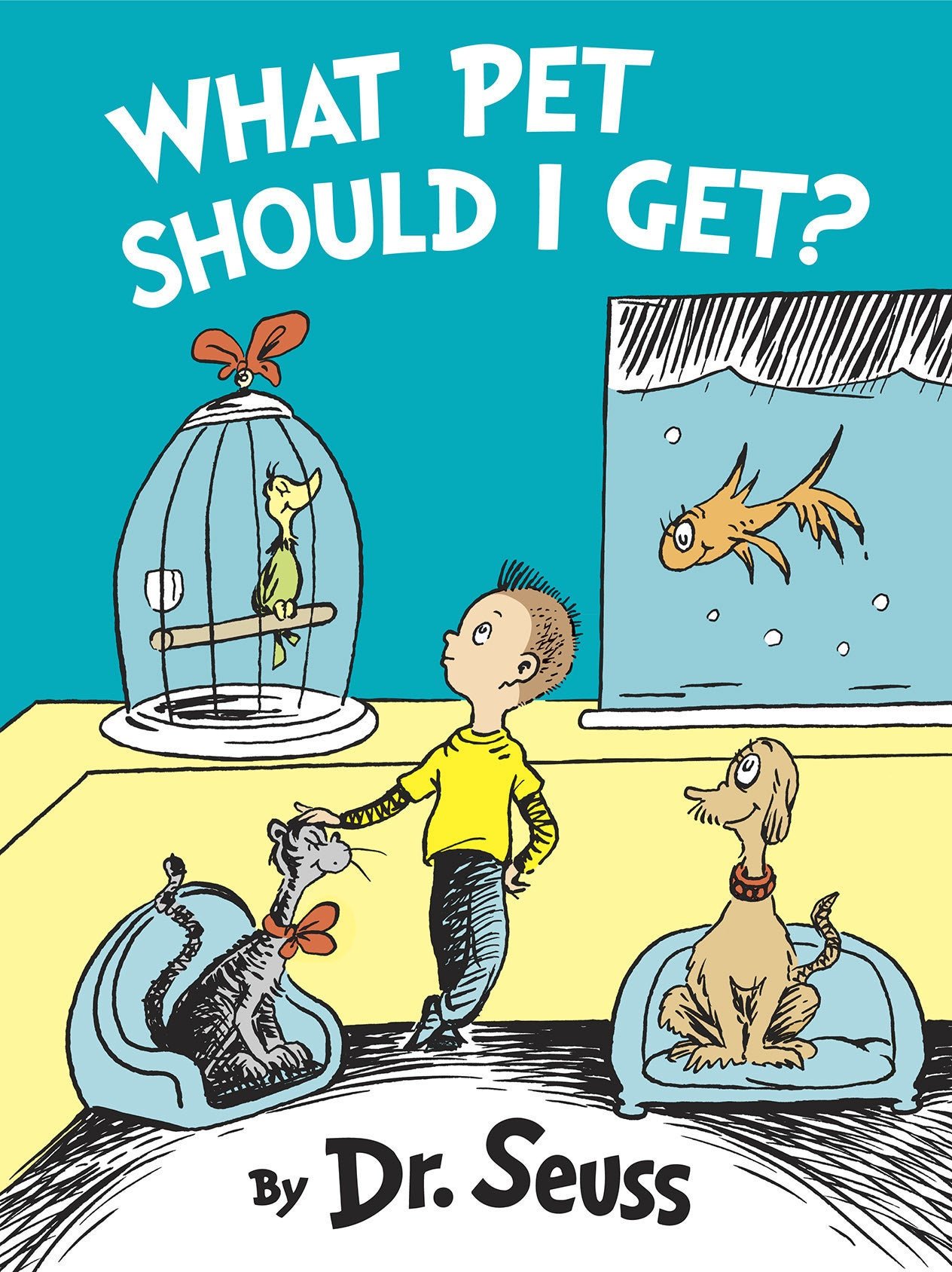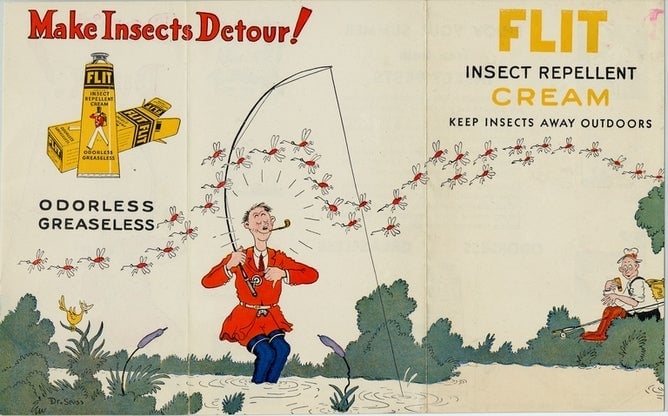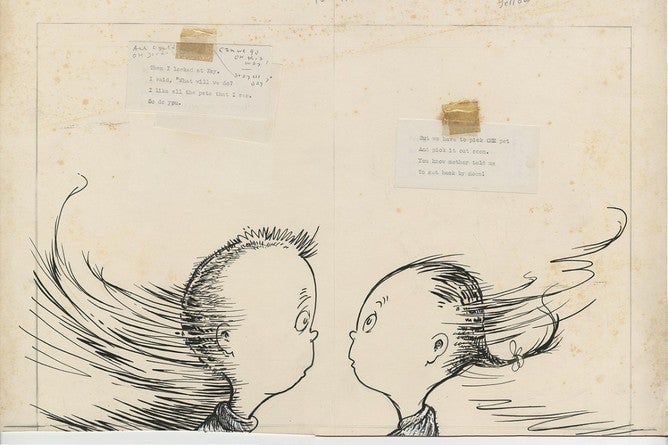Dr. Seuss’s newly discovered book is as relevant today as it was in the 1950s
On February 18, Random House announced the discovery of What Pet Should I Get?, an unpublished—and heretofore unseen—picture book by Dr. Seuss. The announcement came ten days after the same publisher revealed that it would publish Harper Lee’s “discovered” manuscript for Go Set a Watchman in the summer of 2015.


On February 18, Random House announced the discovery of What Pet Should I Get?, an unpublished—and heretofore unseen—picture book by Dr. Seuss. The announcement came ten days after the same publisher revealed that it would publish Harper Lee’s “discovered” manuscript for Go Set a Watchman in the summer of 2015.
In What Pet Should I Get?—released this week—the very same siblings who first appeared in One Fish Two Fish Red Fish Blue Fish now struggle with the question of what pet they should choose.
While the siblings in What Pet Should I Get? may not be as familiar as Scout and Jem Finch, Dr. Seuss’ new book is the latest addition to a body of work that remains just as committed to social justice as Harper Lee’s famous novels.

From Flit to Horton Hears a Who!
Such matters were not always the chief focus of Theodor Geisel (Dr. Seuss’ real name).
In the late 1930s, using the pen name Dr. Seuss, Geisel created cockamamie ad campaigns for Flit bug spray. During the early years of World War II, he contributed notoriously vicious caricatures of the people and leaders of Axis nations for the Popular Front tabloid PM. After joining famous Hollywood director Frank Capra’s Army Signal Corps unit in 1943, he co-created propaganda films under Capra’s tutelage.
However in the years after the war, Dr. Seuss’ art underwent a radical thematic shift. With a flood of eager baby boomer readers, he decided he wanted to speak to the perspective of children.

The racist caricatures of Japanese civilians and soldiers that Dr. Seuss published in PM had drawn on the social prejudice and aggression that Geisel believed lay at the heart of adult humor. So Geisel entrusted Dr. Seuss’ postwar art to the belief that children possessed a sense of fairness and justice that could transform their parents’ world.
Geisel described his 1954 children’s book Horton Hears a Who!, in part, as an apology to the Japanese people his propaganda had demeaned during the war. In subsequent children’s books, he began addressing the major issues of the 20th century: civil rights in The Sneetches (1961), environmental protection in The Lorax (1971) and the nuclear arms race in The Butter Battle Book (1984).
The zany wisdom of Dr. Seuss
In 1960, Geisel spelled out the stakes of his art:
In these days of tension and confusion, writers are beginning to realize that Books for Children have a greater potential for good, or evil, than any other form of literature on earth.
Like To Kill a Mockingbird, One Fish Two Fish Red Fish Blue Fish was published in 1960. And like Mockingbird, the conflicts, tensions and fears of that era are highlighted (albeit indirectly).
One Fish Two Fish Red Fish Blue Fish follows a brother and sister who encounter a series of increasingly fantastic creatures. Nonsensical skits and slapstick gags disrupt the children’s need to decide on a definitive taxonomy—numbers, colors, oppositions, emotional dispositions—for these animals.
The array of sorting mechanisms communicates the siblings’ attraction to different, ever-stranger living things. The book introduces more than a dozen creatures and each is outlandishly distinctive. Most importantly, the children value all of them because of their uniqueness.
Overall, this tale of inclusivity cultivated an appetite for diversity and a delight for change. It rejected the stereotypical ways of regarding persons and things through strict categorization.
Dr. Seuss engaged 1960s unrest more directly in Green Eggs and Ham, also published in 1960. Using visual and verbal eloquence, Dr. Seuss forces the the adult, Grinch-looking creature to confront his stubborn prejudice against green eggs and ham: the character is presented with a series of challenging questions designed to expose the absence of any foundation for his bias.
The adult remains stubborn in his intolerance until his much younger counterpart convinces him that there’s no more basis for his distaste for green eggs and ham than the dislike he’s taken to Sam-I-Am.
The 650 million children who have read Dr. Seuss’ books have been exposed to new ways of viewing the world, of rethinking a social order often imbued in prejudice. But adults continue to use the themes of One Fish Two Fish Red Fish Blue Fish. It has inspired a CEO’s leadership manual, a Barnes & Noble e-reader and the name of a dating website. The book was quoted by Supreme Court Justice Elena Kagan in a dissenting opinion earlier this year.
In 1994, Johnny Valentine and Melody Sarecky even applied it to promote same-sex marriage in their children’s book One Dad, Two Dads, Brown Dad, Blue Dads.

The pet shop that provides the setting for What Pet Should I Get? is inhabited by creatures that display striking resemblances to Horton, the Whos and the Sneetches, along with Sam-I-Am and the fish protagonists of One Fish Two Fish Red Fish Blue Fish. An offshoot of the social vision informing these narratives, What Pet Should I Get? won’t disappoint Dr. Seuss’ readers in the way the Atticus Finch disappointed some To Kill a Mockingbird fans.
As older readers relive their response to a universal question nearly all children face, What Pet Should I Get? will allow a new generation of readers to discover why Dr. Seuss remains forever relevant.
This post originally appeared at The Conversation. Follow @US_conversation on Twitter. We welcome your comments at [email protected].
Image by Martin Pettitt on Flickr, licensed under CC-BY-2.0